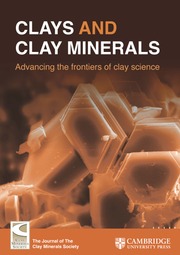Crossref Citations
This article has been cited by the following publications. This list is generated based on data provided by
Crossref.
Eisenlohr, Laurent
Meteva, Krassimira
Gabrovšek, Franci
and
Dreybrodt, Wolfgang
1999.
The inhibiting action of intrinsic impurities in natural calcium carbonate minerals to their dissolution kinetics in aqueous H2O–CO2 solutions.
Geochimica et Cosmochimica Acta,
Vol. 63,
Issue. 7-8,
p.
989.
Heister, Katja
Keijzer, Thomas J.S.
and
Loch, J.P. Gustav
2004.
STABILITY OF CLAY MEMBRANES IN CHEMICAL OSMOSIS.
Soil Science,
Vol. 169,
Issue. 9,
p.
632.
Jaisi, Deb P.
Dong, Hailiang
Kim, Jinwook
He, Ziqi
and
Morton, John P.
2007.
Nontronite particle aggregation induced by microbial Fe(III) reduction and exopolysaccharide production.
Clays and Clay Minerals,
Vol. 55,
Issue. 1,
p.
96.
Mercier, P. H. J.
Le Page, Y.
Tu, Y.
and
Kotlyar, L.
2008.
Powder X-ray Diffraction Determination of Phyllosilicate Mass and Area versus Particle Thickness Distributions for Clays from the Athabasca Oil Sands.
Petroleum Science and Technology,
Vol. 26,
Issue. 3,
p.
307.
Wik, S.
Sparks, B.D.
Ng, S.
Tu, Y.
Li, Z.
Chung, K.H.
and
Kotlyar, L.S.
2008.
Effect of process water chemistry and particulate mineralogy on model oilsands separation using a warm slurry extraction process simulation.
Fuel,
Vol. 87,
Issue. 7,
p.
1394.
Mercier, P. H. J.
Patarachao, B.
Kung, J.
Kingston, D. M.
Woods, J. R.
Sparks, B. D.
Kotlyar, L. S.
Ng, S.
Moran, K.
and
McCracken, T.
2008.
X-ray Diffraction (XRD)-Derived Processability Markers for Oil Sands Based on Clay Mineralogy and Crystallite Thickness Distributions.
Energy & Fuels,
Vol. 22,
Issue. 5,
p.
3174.
Grybos, Malgorzata
Michot, Laurent J.
Skiba, Michal
Billard, Patrick
and
Mustin, Christian
2010.
Dissolution of anisotropic colloidal mineral particles: Evidence for basal surface reactivity of nontronite.
Journal of Colloid and Interface Science,
Vol. 343,
Issue. 2,
p.
433.
Peng, Yongjun
and
Zhao, Shengli
2011.
The effect of surface oxidation of copper sulfide minerals on clay slime coating in flotation.
Minerals Engineering,
Vol. 24,
Issue. 15,
p.
1687.
Mollard, Federico P.O.
Roy, Marie-Claude
Frederick, Kurt
and
Foote, Lee
2012.
Growth of the dominant macrophyte Carex aquatilis is inhibited in oil sands affected wetlands in Northern Alberta, Canada.
Ecological Engineering,
Vol. 38,
Issue. 1,
p.
11.
Zhao, Shengli
and
Peng, Yongjun
2012.
The oxidation of copper sulfide minerals during grinding and their interactions with clay particles.
Powder Technology,
Vol. 230,
Issue. ,
p.
112.
Robert, Tobias
Mercer, Sean M.
Clark, Timothy J.
Mariampillai, Brian E.
Champagne, Pascale
Cunningham, Michael F.
and
Jessop, Philip G.
2012.
Nitrogen-containing polymers as potent ionogens for aqueous solutions of switchable ionic strength: application to separation of organic liquids and clay particles from water.
Green Chemistry,
Vol. 14,
Issue. 11,
p.
3053.
Mercier, P. H. J.
Ng, S.
Moran, K.
Sparks, B. D.
Kingston, D.
Kotlyar, L. S.
Kung, J.
Woods, J.
Patarachao, B.
and
McCracken, T.
2012.
Colloidal Clay Gelation: Relevance to Current Oil Sands Operations.
Petroleum Science and Technology,
Vol. 30,
Issue. 9,
p.
915.
Chen, Chien‐Shun
Lau, Ying Yin
Mercer, Sean M.
Robert, Tobias
Horton, J. Hugh
and
Jessop, Philip G.
2013.
The Effect of Switchable Water Additives on Clay Settling.
ChemSusChem,
Vol. 6,
Issue. 1,
p.
132.
Kostenko, Victoria
and
Martinuzzi, Robert John
2013.
Heavy-oil and Oil-sand Petroleum Systems in Alberta and Beyond.
p.
701.
Żbik, Marek S.
Williams, David J.
Song, Yen-Fang
and
Wang, Chun-Chieh
2014.
The formation of a structural framework in gelled Wyoming bentonite: Direct observation in aqueous solutions.
Journal of Colloid and Interface Science,
Vol. 435,
Issue. ,
p.
119.
Żbik, M.S.
Williams, D.J.
Song, Y.F.
and
Wang, C.C.
2015.
How the hydro-gel flocculation microstructure changes.
Colloids and Surfaces A: Physicochemical and Engineering Aspects,
Vol. 469,
Issue. ,
p.
11.
Botha, Linda
and
Soares, Joao B. P.
2015.
The Influence of Tailings Composition on Flocculation.
The Canadian Journal of Chemical Engineering,
Vol. 93,
Issue. 9,
p.
1514.
Gorakhki, Mohammad H.
and
Bareither, Christopher A.
2015.
Salinity effects on sedimentation behavior of kaolin, bentonite, and soda ash mine tailings.
Applied Clay Science,
Vol. 114,
Issue. ,
p.
593.
Quinlan, Patrick James
and
Tam, Kam Chiu
2015.
Water treatment technologies for the remediation of naphthenic acids in oil sands process-affected water.
Chemical Engineering Journal,
Vol. 279,
Issue. ,
p.
696.
Pramanik, Sudipta
2016.
Review of biological processes in oil sands: a feasible solution for tailings water treatment.
Environmental Reviews,
Vol. 24,
Issue. 3,
p.
274.

